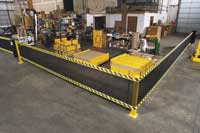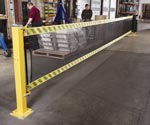
Avoiding Serious Accidents Can Be Easy
Industrial safety barriers have evolved to address a host of safety and productivity issues, leading to a wide range of easy-to-use, adaptable solutions
- By Andy Olson
- Apr 01, 2009
 Sometimes the most serious industrial accidents are the easiest ones to avoid. For instance, there's a relatively simple way to keep forklifts and pedestrians from falling off loading docks and to prevent forklifts from crashing through closed dock doors. And it doesn't take much to keep employees from walking into prohibited areas and becoming seriously injured by machinery. The same is true when the goal is to ensure pedestrians are safe from forklifts and pallet jacks.
Sometimes the most serious industrial accidents are the easiest ones to avoid. For instance, there's a relatively simple way to keep forklifts and pedestrians from falling off loading docks and to prevent forklifts from crashing through closed dock doors. And it doesn't take much to keep employees from walking into prohibited areas and becoming seriously injured by machinery. The same is true when the goal is to ensure pedestrians are safe from forklifts and pallet jacks.
The solution is industrial safety barriers. When combined with a well-designed safety plan, these relatively easy-to-use devices greatly minimize the risks associated with a host of potentially disastrous accidents that threaten the safety and productivity of virtually any fast-paced industrial environment. The concept of safety barriers isn't new because it is rooted in the fundamentals of workplace safety. Yet many are unaware of how the devices have evolved to better suit the needs of decision-makers and users alike. Technological advancements have also led to new designs and an array of options. Knowing what to use and when and where goes a long way toward ensuring a safe and profitable operation.
Protecting People, Products, Equipment
Safety barriers designed for industrial use cover a broad range of applications and functions. In the broadest sense, they provide protection and help improve productivity. The devices should not to be confused with machine guards, which protect machine operators from a machine's moving parts.
Industrial safety barriers are primarily used to protect people from multiple safety risks, which include forklift impacts and dangers associated with loading docks. Another form of protection is to keep employees or visitors from entering restricted areas. The devices also guard against damage to material handling equipment and products, as well as production machinery and storage equipment. By so doing, they minimize the potential for unnecessary costs and unplanned downtime.
For years, the choices in safety barriers were limited to traditional steel guardrails. However, the guardrails are not the best solution for every application because they sometimes provide more protection than needed for the cost. Another factor driving better safety barrier technology involves flexibility; users wanted more in the way of accessibility and adaptability. The limitations and expense of traditional steel guardrails are why some have gone so far as to forgo the use of guardrails—often with increased safety risk.
The need for more options, combined with a host of new safety and productivity issues, sparked a number of innovations. Over time, two categories of barriers evolved. The first is in-plant separation barriers. The other encompasses loading dock barriers and gates. The operating environment, along with a host of application-specific factors, drives the selection process.
In-Plant Separation Systems
There are two main types of in-plant separation systems: fabric safety barriers and fixedguardrail units. Both separate and define work areas, walkways, and interior loading docks and protect pedestrians, machinery, equipment,workstations, and products from the dangers of material handling equipment. They also address the shortcomings of painted yellow lines on the floor. Painted lines often fade and provide limited visibility with little, if any, added benefit.
Fabric safety barriers generally consist of mesh curtains and/or straps stretched between steel mounting posts. They are highly adaptable and provide the flexibility that most operations require. With flexibility comes increased productivity. Some examples of flexibility include frequent removal of the barrier to gain full access to a specific area or the need to change the barrier configuration to better match changes in a facility's layout and/or production processes.
Among the key factors to consider when specifying fabric safety barriers is the amount of stopping power provided. Some are only meant to provide a substantial visual and physical barrier. Others not only provide the visual barrier but also can stop a forklift weighing up to 10,000 pounds traveling up to 4 mph. Another key consideration is ease of use. With some units, one person can remove and reposition the barrier in less than 10 seconds.
Like fabric safety barriers, newer fixed guardrail barriers address the need for ease of access and adaptability. Some light-duty systems, for example, are modular in design and feature flexible PVC railings that can be easily removed and replaced. Most are designed to absorb incidental impacts from material handling equipment. Traditional steel guardrails, on the other hand, provide maximum stopping power. They're often used when a high degree of protection is needed from material handling equipment. Typical applications include workstations and pallet storage areas. The railings of both light- and heavy-duty systems are connected via steel mounting posts.
Another type of fixed-guardrail is a permanent steel barrier located along the floor of a facility. The barrier can be used as a stand-alone unit or added on to a light- or heavy-duty system to provide an extra level of protection. The floor-mounted barrier, which is secured without the use of uprights, provides maximum protection against the dangers of lift trucks traveling with forks in the down position and the potential damage they can cause to walls, racking, and production equipment.
Whether it's a floor-mounted barrier, flexible fabric barrier, or lightweight, fixedguardrail barrier, there's no shortage of options when it comes to in-plant separation systems.
Addressing Safety at the Dock
An equally broad range of solutions is available to protect against dangers at the loading dock—and these continue to pose a serious safety risk. According to a recent OSHA report, 10-20 percent of all industrial accidents occur at or around the dock.
Loading dock barriers and gates guard against dock drop-off, which is one of the most potentially devastating industrial accidents. Dock drop-off occurs when pedestrians or material handling equipment fall off the edge of a dock. The accident typically involves a 4-foot drop to the ground outside the raised dock platform and can happen when a dock door is open or closed. Many of the same systems also prevent people and material handling equipment from falling off elevated areas inside a facility, such as a raised platform and mezzanine.
Most systems meet OSHA's 29 CFR 1910.23 regarding "protection for wall openings and holes." Safety-minded companies often use dock barriers and gates in place of a single chain across the dock door. The use of a chain is an outdated practice that offers minimal, if any, protection against dock drop-off when material handling equipment is involved.
A fabric dock barrier typically consists of a highly visible mesh curtain that spans the dock door opening. The curtain, which is often reinforced with restraint straps, manually connects to steel guards mounted on each side of the door. The door guards protect the tracks of overhead doors from impact-related damage. Light-duty models are typically designed to prevent pedestrians, carts, and non-motorized lift trucks from falling off the dock. In addition to stopping power, a key consideration when selecting barriers is ease of use. Newer units allow users to extend the barrier across the opening within seconds and store the curtain just as quickly and easily. An equally important factor is the system's ability to protect the tracks of the dock door against damage and costly downtime.
Safety gates offer yet another option for protection at the dock and other locations throughout virtually any industrial facility. Heavy-duty gates are designed to stop a forklift, while light-duty gates provide protection against incidental material handling impacts. The gates can be automatically or manually operated. An automatically operated unit typically consists of two highly visible straps that connect to two steel, vertical columns on opposite sides of the unit. Operators use a push-button control to open and close the gate, which travels up and down the vertical columns. Some systems can be integrated with the dock door and other dock equipment. A manual gate typically opens and closes with a latching system. Lightweight, easy-to-use systems are an attractive option for in-plant work areas where frequent access is needed.
Making the Right Choice
Industrial safety barriers have come a long way since the days when the choice was limited to traditional steel guardrails. The issue moving forward is to choose the right type of barrier,or combination of barrier systems, that best aligns with the operation's needs and its philosophy toward safety. Given the critical nature of safety barriers and the wide range of options available, decision-makers will come out ahead by looking to a proven and knowledgeable supplier to help guide the decision.
About the Author
Andy Olson is the director of marketing for Rite-Hite Engineered Solutions. Rite-Hite is a manufacturer of loading dock equipment, industrial doors, safety barriers, HVLS fans, industrial curtain walls, and more, all designed to improve safety, security, productivity, energy consumption, and environmental control. For more information, visit www.ritehite.com. The information herein is provided as a general reference regarding the use of the applicable product(s) in specific applications. This information is provided without warranty. It is your responsibility to ensure that you are using all mentioned products properly in your specific application and in accordance with all laws and regulations.